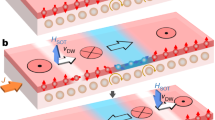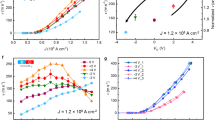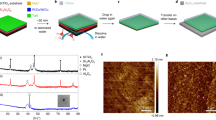Abstract
The manipulation of fast domain wall motion in magnetic nanostructures could form the basis of novel magnetic memory and logic devices. However, current approaches for reading and writing domain walls require external magnetic fields, or are based on conventional magnetic tunnel junctions (MTJs) that are not compatible with high-speed domain wall motion. Here we report domain wall devices based on perpendicular MTJs that offer electrical read and write, and fast domain wall motion via spin–orbit torque. The devices have a hybrid free layer design that consists of platinum/cobalt (Pt/Co) or a synthetic antiferromagnet (Pt/Co/Ru/Co) into the free layer of conventional MTJs. We show that our devices can achieve good tunnelling magnetoresistance readout and efficient spin-transfer torque writing that is comparable to current magnetic random-access memory technology, as well as domain wall depinning efficiency that is similar to stand-alone materials. We also show that a domain wall conduit based on a synthetic antiferromagnet offers the potential for reliable domain wall motion and faster write speed compared with a device based on Pt/Co.
This is a preview of subscription content, access via your institution
Access options
Access Nature and 54 other Nature Portfolio journals
Get Nature+, our best-value online-access subscription
$29.99 / 30 days
cancel any time
Subscribe to this journal
Receive 12 digital issues and online access to articles
$119.00 per year
only $9.92 per issue
Buy this article
- Purchase on Springer Link
- Instant access to full article PDF
Prices may be subject to local taxes which are calculated during checkout





Similar content being viewed by others
Data availability
The data that support the plots within this paper and other findings of this study are available from the corresponding authors upon reasonable request.
References
Dieny, B. et al. Opportunities and challenges for spintronics in the microelectronics industry. Nat. Electron. 3, 446–459 (2020).
Manchon, A. et al. Current-induced spin–orbit torques in ferromagnetic and antiferromagnetic systems. Rev. Mod. Phys. 91, 035004 (2019).
Parkin, S., Hayashi, M. & Thomas, L. Magnetic domain-wall racetrack memory. Science 320, 190–194 (2008).
Blasing, R. et al. Magnetic racetrack memory: from physics to the cusp of applications within a decade. Proc. IEEE 108, 1303–1321 (2020).
Allwood, D. A. et al. Magnetic domain-wall logic. Science 309, 1688–1692 (2005).
Nikonov, D., Bourianoff, G. & Ghani, T. Proposal of a spin torque majority gate. IEEE Electron Device Lett. 32, 1128–1130 (2011).
Hu, X., Timm, A., Brigner, W. H., Incorvia, J. A. C. & Friedman, J. S. SPICE-only model for spin-transfer torque domain wall MTJ logic. IEEE Trans. Electron Devices 66, 2817–2821 (2019).
Luo, Z. et al. Current-driven magnetic domain-wall logic. Nature 579, 214–218 (2020).
Siddiqui, S. et al. Magnetic domain wall based synaptic and activation function generator for neuromorphic accelerators. Nano Lett. 20, 1033–1040 (2019).
Grollier, J. et al. Neuromorphic spintronics. Nat. Electron 3, 360–370 (2020).
Yue, K., Liu, Y., Lake, R. K. & Parker, A. C. A brain-plausible neuromorphic on-the-fly learning system implemented with magnetic domain wall analog memristors. Sci. Adv. 5, eaau8170 (2019).
Miron, M. et al. Fast current-induced domain-wall motion controlled by the Rashba effect. Nat. Mater. 10, 419–423 (2011).
Emori, S., Bauer, U., Ahn, S.-M., Martinez, E. & Beach, G. S. Current-driven dynamics of chiral ferromagnetic domain walls. Nat. Mater. 12, 611–616 (2013).
Avci, C. O. et al. Interface-driven chiral magnetism and current-driven domain walls in insulating magnetic garnets. Nat. Nanotechnol. 14, 561–566 (2019).
Thiaville, A., Rohart, S., Jue, E., Cros, V. & Fert, A. Dynamics of Dzyaloshinskii domain walls in ultrathin magnetic films. Europhys. Lett. 100, 57002 (2012).
Yang, S.-H., Ryu, K.-S. & Parkin, S. Domain-wall velocities of up to 750 m s−1 driven by exchange-coupling torque in synthetic antiferromagnets. Nat. Nanotechnol. 10, 221–226 (2015).
Kim, K.-J. et al. Fast domain wall motion in the vicinity of the angular momentum compensation temperature of ferrimagnets. Nat. Mater. 16, 1187–1192 (2017).
Ikeda, S. et al. A perpendicular-anisotropy CoFeB–MgO magnetic tunnel junction. Nat. Mater. 9, 721–724 (2010).
Burrowes, C. et al. Low depinning fields in Ta–CoFeB–MgO ultrathin films with perpendicular magnetic anisotropy. Appl. Phys. Lett. 103, 182401 (2013).
Raymenants, E. et al. Scaled spintronic logic device based on domain wall motion in magnetically interconnected tunnel junctions. In Proc. 2018 IEEE International Electron Devices Meeting (IEDM) 36.4.1–36.4.4 (IEEE, 2018).
Wan, D. et al. Fabrication of magnetic tunnel junctions connected through a continuous free layer to enable spin logic devices. Jpn J. Appl. Phys. 57, 04FN01 (2018).
Liu, E. et al. Control of interlayer exchange coupling and its impact on spin–torque switching of hybrid free layers with perpendicular magnetic anisotropy. IEEE Trans. Magn. 53, 1–5 (2017).
Perrissin, N. et al. A highly thermally stable sub-20-nm magnetic random-access memory based on perpendicular shape anisotropy. Nanoscale 10, 12187–12195 (2018).
Duine, R., Lee, K.-J., Parkin, S. S. & Stiles, M. D. Synthetic antiferromagnetic spintronics. Nat. Phys. 14, 217–219 (2018).
Avilés-Félix, L. et al. Single-shot all-optical switching of magnetization in Tb/Co multilayer based electrodes. Sci. Rep. 10, 5211 (2020).
Legrand, W. et al. Room-temperature current-induced generation and motion of sub-100-nm skyrmions. Nat. Mater. 19, 34–42 (2020).
Dohi, T., DuttaGupta, S., Fukami, S. & Ohno, H. Formation and current-induced motion of synthetic antiferromagnetic skyrmion bubbles. Nat. Commun. 10, 5153 (2019).
Talmelli, G. et al. Reconfigurable submicrometer spin–wave majority gate with electrical transducers. Sci. Adv. 6, eabb4042 (2020).
Hirohata, A. et al. Review on spintronics: principles and device applications. J. Magn. Magn. Mater. 509, 166711 (2020).
Raymenants, E. et al. All-electrical control of scaled spin logic devices based on domain wall motion. IEEE Trans. Electron Devices 68, 2116–2122 (2021).
Devolder, T. et al. Damping of CoxFe80-xB20 ultrathin films with perpendicular magnetic anisotropy. Appl. Phys. Lett. 102, 022407 (2013).
Bouquin, P., Rao, S., Kar, G. S. & Devolder, T. Size dependence of spin–torque switching in perpendicular magnetic tunnel junctions. Appl. Phys. Lett. 113, 222408 (2018).
Alzate, J. G. et al. 2-MB array-level demonstration of STT-MRAM process and performance towards L4 cache applications. In Proc. 2019 IEEE International Electron Devices Meeting (IEDM) 2–4 (IEEE, 2019).
Brown, W. F. J. Thermal fluctuations of a single-domain particle. Phys. Rev. 130, 1677 (1963).
Raymenants, E. et al. All-electrical control of scaled spin logic devices based on domain wall motion. In Proc. 2020 IEEE International Electron Devices Meeting (IEDM) 21–25 (IEEE, 2020).
Fukami, S., Ieda, J. & Ohno, H. Thermal stability of a magnetic domain wall in nanowires. Phys. Rev. B 91, 235401 (2015).
Haazen, P. et al. Domain wall depinning governed by the spin Hall effect. Nat. Mater. 12, 299–303 (2013).
Metaxas, P. J. et al. Creep and flow regimes of magnetic domain-wall motion in ultrathin Pt/Co/Pt films with perpendicular anisotropy. Phys. Rev. Lett. 99, 217208 (2007).
Acknowledgements
This work was performed as part of the imec IIAP core CMOS and the Beyond CMOS Program of Intel Corporation. We acknowledge J. Heijlen and the P-line for operational support. The magneto-optic Kerr effect microscopy experiments were performed at Technische Universiteit Eindhoven and we thank R. Lavrijsen for assistance. E.R. acknowledges FWO-Vlaanderen for a Strategic Basic Research PhD fellowship.
Author information
Authors and Affiliations
Contributions
V.D.N. and S.C. conceived the HFL design for DW devices and managed the project. E.R. and V.D.N. were in charge of device characterizations, with help from K.G., S.C., D.W., I.R., I.A., I.A.Y., D.E.N., B.S. and M.H. E.R., O.B., V.D.N. and T.D. performed the time-resolved experiments and interpreted the results. D.W. was in charge of the device integration process. Devices were fabricated by D.W., Y.C., L.S., A.T. and D.T. The thin films were deposited by S.C. O.B. reported on the time-resolved measurements of single pillars. E.R., K.G. and V.D.N. wrote the manuscript. All authors discussed the results and commented on the manuscript.
Corresponding authors
Ethics declarations
Competing interests
The authors declare no competing interests.
Additional information
Peer review information Nature Electronics thanks Guoqiang Yu, Kaiyou Wang and the other, anonymous, reviewer(s) for their contribution to the peer review of this work.
Publisher’s note Springer Nature remains neutral with regard to jurisdictional claims in published maps and institutional affiliations.
Extended data
Extended Data Fig. 1 Representation of current flow for electrical operation of DW device.
Current path for reading and writing displayed for center pillar (a) and for DW motion driven by spin orbit torque (SOT) (b).
Extended Data Fig. 2 Fabrication process in imec’s 300 mm pilot line.
(a) Bottom electrode contact (BEC), BEC feedlines and contact plugs were defined. (b) MTJ stack deposition using ultra-high vacuum magnetron sputtering system (c) Pillar patterning by 193 nm immersion lithography followed by ion-beam-etch (d) Free layer shape is defined by 193 nm immersion lithography double patterning (e) Dual damascene Cu top contact formation (f) 3-dimensional image of DW device with individual top electrode for each pillar.
Extended Data Fig. 3 Comparison of coercive field and propagation field.
(a) The coercive field BC is the switching field obtained during a conventional R(H) loop. The propagation field BP is obtained after STT-driven nucleation in the center pillar (P2) and consecutive sweeping of the z-field from 0 mT upwards. The domain then expands to the outer pillars (P1 and P3). (b) Box plots of the coercive and propagation fields of 10 measurements. The average coercive field is 61 mT while the propagation field to both pillars is only 33 mT. (c) Demonstration of the initial state of the device before the R(H) loop is initiated. Device is fully saturated to obtain coercive field BC (top), a domain was initially nucleated in P2 to obtain the propagation field BP (bottom).
Extended Data Fig. 4 Reproducibility of spin-orbit torque-driven DW motion in operation mode.
STT nucleation in P2 followed by SOT-transport to P3 with positive current (top) and SOT-transport to P1 with negative current (bottom). Measurement ~100 x reproducible with each current polarity as described in Fig. 4e,f. The DW never propagates to the reverse direction, that is, no switch in P1 (top) and P3 (bottom).
Extended Data Fig. 5 Demonstration of spin-orbit torque-driven DW motion from different inputs.
(Top left) Resistance versus field loop displays the coercive field BC, the propagation field BP and the assist field BA for SOT-driven motion. The schematics at the top display the applied current polarity and direction of DW motion. The domain is nucleated by STT in P1 (second row), P2 (third row), and P3 (fourth row) as shown by the schematics on the left. In the last case (fifth row), no domain is nucleated by STT. The latter confirms that all the above are SOT-driven propagation of DWs, and not SOT-driven DW nucleation.
Supplementary information
Supplementary Information
Supplementary discussion, consisting of Supplementary Notes 1–6 and Figs. 1.1, 2.2.2, 3.1, 3.1.1, 3.1.2, 3.1.3, 3.1.4, 4.1, 4.2, 4.3, 4.4, 5.1, 5.2, 5.3, 6.1.1, 6.1.2, 6.2.1, 6.2.2, 6.3 and 6.4.
Supplementary Video 1
Non-uniform domain wall transport in a Pt/Co track driven by spin–orbit torque.
Supplementary Video 2
Uniform and fast domain wall transport in a synthetic antiferromagnetic track driven by spin–orbit torque.
Rights and permissions
About this article
Cite this article
Raymenants, E., Bultynck, O., Wan, D. et al. Nanoscale domain wall devices with magnetic tunnel junction read and write. Nat Electron 4, 392–398 (2021). https://doi.org/10.1038/s41928-021-00593-x
Received:
Accepted:
Published:
Issue Date:
DOI: https://doi.org/10.1038/s41928-021-00593-x



